Business Communication: Case Study Analysis, Solutions, and Email
VerifiedAdded on 2020/04/01
|7
|1415
|164
Homework Assignment
AI Summary
This assignment analyzes business communication concepts through a case study. It defines key terms like communication, sender, and receiver, and identifies communication barriers such as lack of proper communication medium, distractions, and differences in perception. The assignment explores different channels of communication including face-to-face, downward, horizontal, broadcast media, and electronic communication. It further examines non-verbal codes like kinesics, proxemics, physical appearance, and environment, providing examples from the case. The assignment also addresses diversity, ethnocentricity, and stereotyping, providing examples from the case. Finally, it includes an email to Shakti offering consultancy services. The document provides a comprehensive overview of the communication process, its challenges, and potential solutions within a business context.
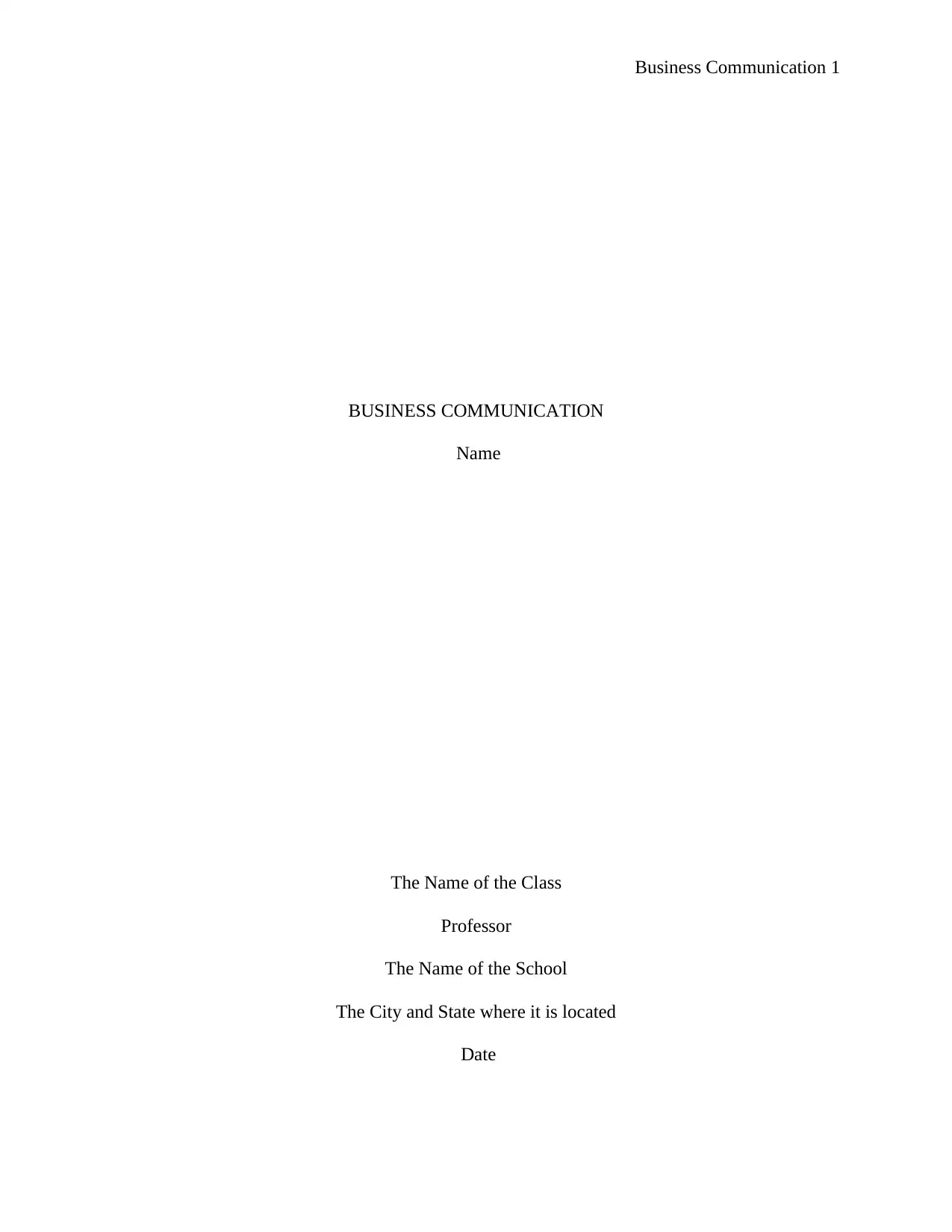
Business Communication 1
BUSINESS COMMUNICATION
Name
The Name of the Class
Professor
The Name of the School
The City and State where it is located
Date
BUSINESS COMMUNICATION
Name
The Name of the Class
Professor
The Name of the School
The City and State where it is located
Date
Paraphrase This Document
Need a fresh take? Get an instant paraphrase of this document with our AI Paraphraser
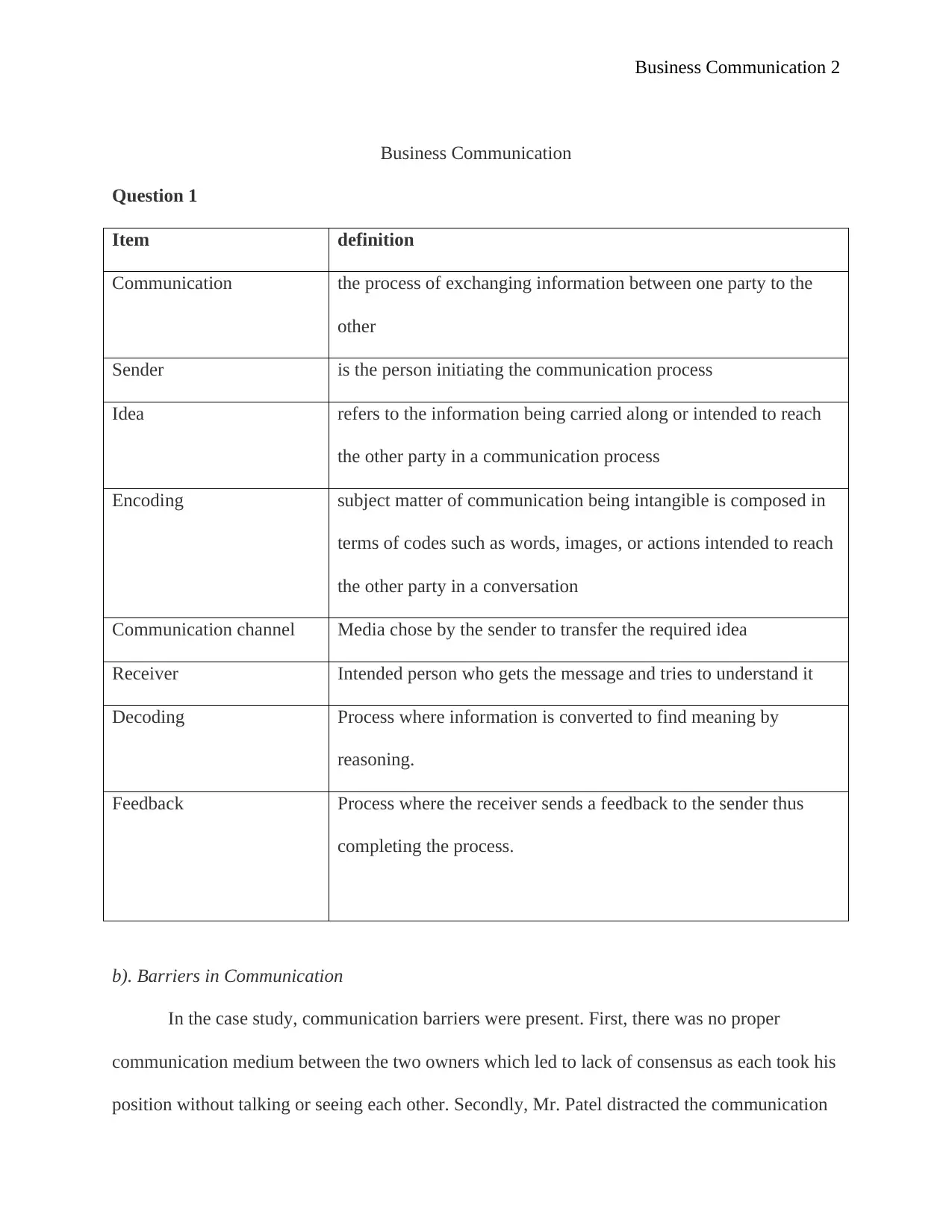
Business Communication 2
Business Communication
Question 1
Item definition
Communication the process of exchanging information between one party to the
other
Sender is the person initiating the communication process
Idea refers to the information being carried along or intended to reach
the other party in a communication process
Encoding subject matter of communication being intangible is composed in
terms of codes such as words, images, or actions intended to reach
the other party in a conversation
Communication channel Media chose by the sender to transfer the required idea
Receiver Intended person who gets the message and tries to understand it
Decoding Process where information is converted to find meaning by
reasoning.
Feedback Process where the receiver sends a feedback to the sender thus
completing the process.
b). Barriers in Communication
In the case study, communication barriers were present. First, there was no proper
communication medium between the two owners which led to lack of consensus as each took his
position without talking or seeing each other. Secondly, Mr. Patel distracted the communication
Business Communication
Question 1
Item definition
Communication the process of exchanging information between one party to the
other
Sender is the person initiating the communication process
Idea refers to the information being carried along or intended to reach
the other party in a communication process
Encoding subject matter of communication being intangible is composed in
terms of codes such as words, images, or actions intended to reach
the other party in a conversation
Communication channel Media chose by the sender to transfer the required idea
Receiver Intended person who gets the message and tries to understand it
Decoding Process where information is converted to find meaning by
reasoning.
Feedback Process where the receiver sends a feedback to the sender thus
completing the process.
b). Barriers in Communication
In the case study, communication barriers were present. First, there was no proper
communication medium between the two owners which led to lack of consensus as each took his
position without talking or seeing each other. Secondly, Mr. Patel distracted the communication

Business Communication 3
process by speaking in a low tone which made Thandeka not to understand the conversation
(Quintanilla and Wahl 2015). Thirdly, Mr. Patel failed to issue his message wholesomely in a
manner that could be understood by the employees regarding stating his reasons for the change
of routes. At the same time, the barrier of difference in perception was evident, where Mr.
Lewane failed to recognize religious differences thus failing to observe the Friday prayers for the
Muslims and ending up firing Josef Khalifa (Ferraro and Briody, 2017). Lack of interest as a
barrier was evident in the reaction by the drivers who saw the communication process as
oppressive and kept shouting thus distorting the process.
c). Channels of communication
Face to face communication- the process involves speaking with one another on a
physical basis where a message is interpreted as the other speaks (Men, L.R., 2014). The mode is
present in the case study as seen where Mr. Patel talks to the truck drivers on a face to face
meeting. At the same time, a downward communication system is used in the organization where
the authority flows from the top management directly to the lower level employees. Horizontal
communication is equally evident in the case where one of the drivers speaks to the colleagues
regarding the message being delivered by Mr. Patel (Miller and Barbour, 2014).
Broadcast Media
The media involves radio, tv and others meant for reaching the mass audience.
Electronic
Involves the writing of emails from one person to another to transfer and receive feedback on
messages. It is an efficient method which is less personal.
Written
process by speaking in a low tone which made Thandeka not to understand the conversation
(Quintanilla and Wahl 2015). Thirdly, Mr. Patel failed to issue his message wholesomely in a
manner that could be understood by the employees regarding stating his reasons for the change
of routes. At the same time, the barrier of difference in perception was evident, where Mr.
Lewane failed to recognize religious differences thus failing to observe the Friday prayers for the
Muslims and ending up firing Josef Khalifa (Ferraro and Briody, 2017). Lack of interest as a
barrier was evident in the reaction by the drivers who saw the communication process as
oppressive and kept shouting thus distorting the process.
c). Channels of communication
Face to face communication- the process involves speaking with one another on a
physical basis where a message is interpreted as the other speaks (Men, L.R., 2014). The mode is
present in the case study as seen where Mr. Patel talks to the truck drivers on a face to face
meeting. At the same time, a downward communication system is used in the organization where
the authority flows from the top management directly to the lower level employees. Horizontal
communication is equally evident in the case where one of the drivers speaks to the colleagues
regarding the message being delivered by Mr. Patel (Miller and Barbour, 2014).
Broadcast Media
The media involves radio, tv and others meant for reaching the mass audience.
Electronic
Involves the writing of emails from one person to another to transfer and receive feedback on
messages. It is an efficient method which is less personal.
Written
⊘ This is a preview!⊘
Do you want full access?
Subscribe today to unlock all pages.

Trusted by 1+ million students worldwide
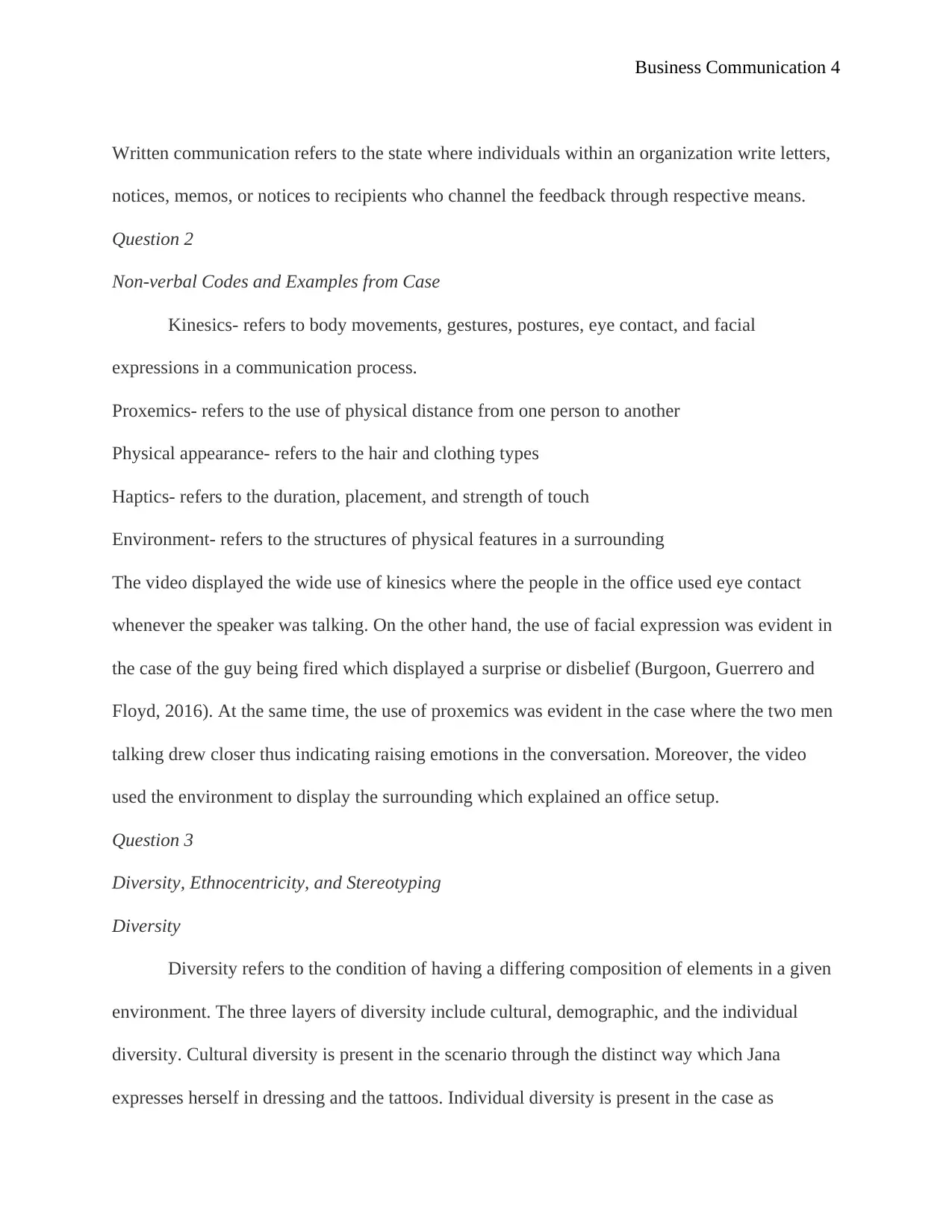
Business Communication 4
Written communication refers to the state where individuals within an organization write letters,
notices, memos, or notices to recipients who channel the feedback through respective means.
Question 2
Non-verbal Codes and Examples from Case
Kinesics- refers to body movements, gestures, postures, eye contact, and facial
expressions in a communication process.
Proxemics- refers to the use of physical distance from one person to another
Physical appearance- refers to the hair and clothing types
Haptics- refers to the duration, placement, and strength of touch
Environment- refers to the structures of physical features in a surrounding
The video displayed the wide use of kinesics where the people in the office used eye contact
whenever the speaker was talking. On the other hand, the use of facial expression was evident in
the case of the guy being fired which displayed a surprise or disbelief (Burgoon, Guerrero and
Floyd, 2016). At the same time, the use of proxemics was evident in the case where the two men
talking drew closer thus indicating raising emotions in the conversation. Moreover, the video
used the environment to display the surrounding which explained an office setup.
Question 3
Diversity, Ethnocentricity, and Stereotyping
Diversity
Diversity refers to the condition of having a differing composition of elements in a given
environment. The three layers of diversity include cultural, demographic, and the individual
diversity. Cultural diversity is present in the scenario through the distinct way which Jana
expresses herself in dressing and the tattoos. Individual diversity is present in the case as
Written communication refers to the state where individuals within an organization write letters,
notices, memos, or notices to recipients who channel the feedback through respective means.
Question 2
Non-verbal Codes and Examples from Case
Kinesics- refers to body movements, gestures, postures, eye contact, and facial
expressions in a communication process.
Proxemics- refers to the use of physical distance from one person to another
Physical appearance- refers to the hair and clothing types
Haptics- refers to the duration, placement, and strength of touch
Environment- refers to the structures of physical features in a surrounding
The video displayed the wide use of kinesics where the people in the office used eye contact
whenever the speaker was talking. On the other hand, the use of facial expression was evident in
the case of the guy being fired which displayed a surprise or disbelief (Burgoon, Guerrero and
Floyd, 2016). At the same time, the use of proxemics was evident in the case where the two men
talking drew closer thus indicating raising emotions in the conversation. Moreover, the video
used the environment to display the surrounding which explained an office setup.
Question 3
Diversity, Ethnocentricity, and Stereotyping
Diversity
Diversity refers to the condition of having a differing composition of elements in a given
environment. The three layers of diversity include cultural, demographic, and the individual
diversity. Cultural diversity is present in the scenario through the distinct way which Jana
expresses herself in dressing and the tattoos. Individual diversity is present in the case as
Paraphrase This Document
Need a fresh take? Get an instant paraphrase of this document with our AI Paraphraser
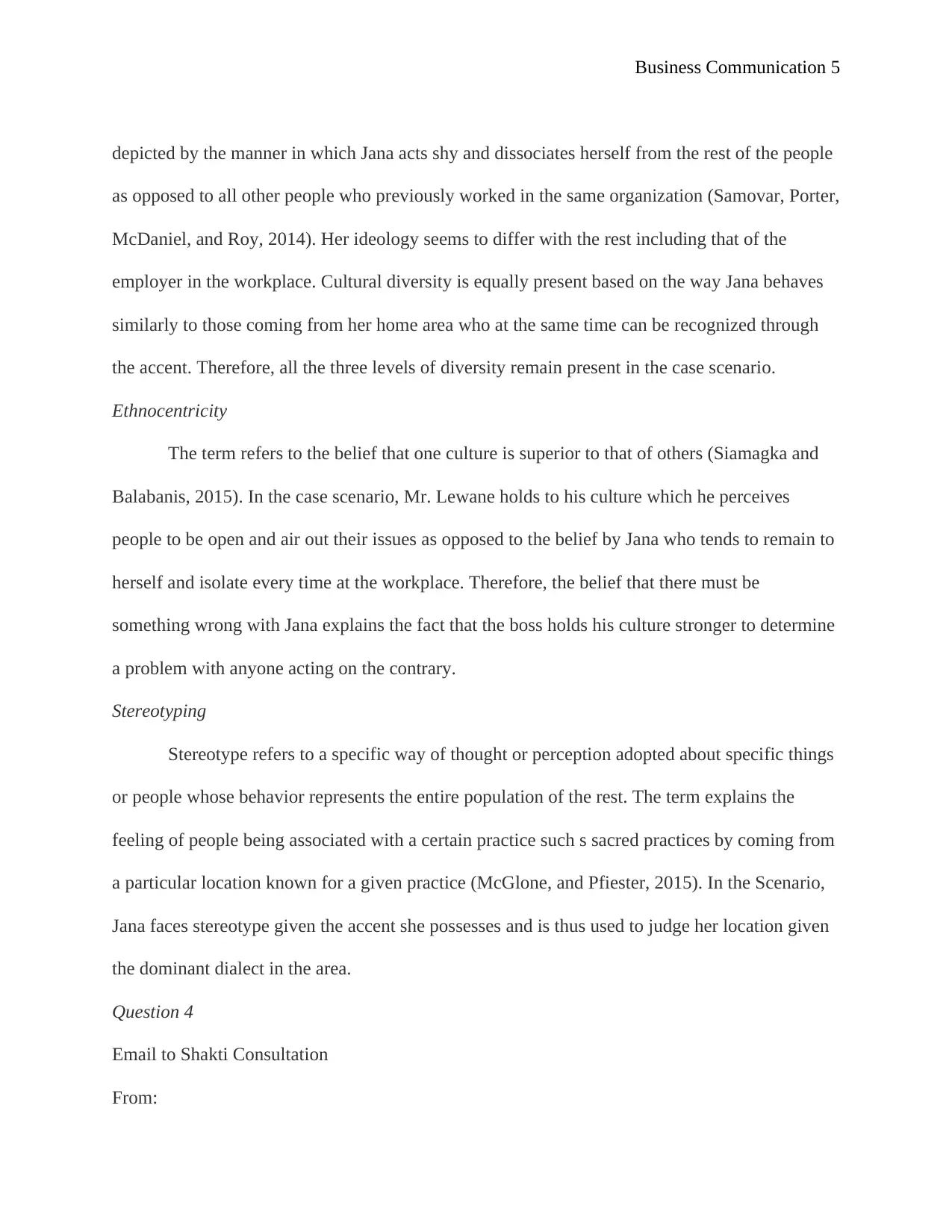
Business Communication 5
depicted by the manner in which Jana acts shy and dissociates herself from the rest of the people
as opposed to all other people who previously worked in the same organization (Samovar, Porter,
McDaniel, and Roy, 2014). Her ideology seems to differ with the rest including that of the
employer in the workplace. Cultural diversity is equally present based on the way Jana behaves
similarly to those coming from her home area who at the same time can be recognized through
the accent. Therefore, all the three levels of diversity remain present in the case scenario.
Ethnocentricity
The term refers to the belief that one culture is superior to that of others (Siamagka and
Balabanis, 2015). In the case scenario, Mr. Lewane holds to his culture which he perceives
people to be open and air out their issues as opposed to the belief by Jana who tends to remain to
herself and isolate every time at the workplace. Therefore, the belief that there must be
something wrong with Jana explains the fact that the boss holds his culture stronger to determine
a problem with anyone acting on the contrary.
Stereotyping
Stereotype refers to a specific way of thought or perception adopted about specific things
or people whose behavior represents the entire population of the rest. The term explains the
feeling of people being associated with a certain practice such s sacred practices by coming from
a particular location known for a given practice (McGlone, and Pfiester, 2015). In the Scenario,
Jana faces stereotype given the accent she possesses and is thus used to judge her location given
the dominant dialect in the area.
Question 4
Email to Shakti Consultation
From:
depicted by the manner in which Jana acts shy and dissociates herself from the rest of the people
as opposed to all other people who previously worked in the same organization (Samovar, Porter,
McDaniel, and Roy, 2014). Her ideology seems to differ with the rest including that of the
employer in the workplace. Cultural diversity is equally present based on the way Jana behaves
similarly to those coming from her home area who at the same time can be recognized through
the accent. Therefore, all the three levels of diversity remain present in the case scenario.
Ethnocentricity
The term refers to the belief that one culture is superior to that of others (Siamagka and
Balabanis, 2015). In the case scenario, Mr. Lewane holds to his culture which he perceives
people to be open and air out their issues as opposed to the belief by Jana who tends to remain to
herself and isolate every time at the workplace. Therefore, the belief that there must be
something wrong with Jana explains the fact that the boss holds his culture stronger to determine
a problem with anyone acting on the contrary.
Stereotyping
Stereotype refers to a specific way of thought or perception adopted about specific things
or people whose behavior represents the entire population of the rest. The term explains the
feeling of people being associated with a certain practice such s sacred practices by coming from
a particular location known for a given practice (McGlone, and Pfiester, 2015). In the Scenario,
Jana faces stereotype given the accent she possesses and is thus used to judge her location given
the dominant dialect in the area.
Question 4
Email to Shakti Consultation
From:
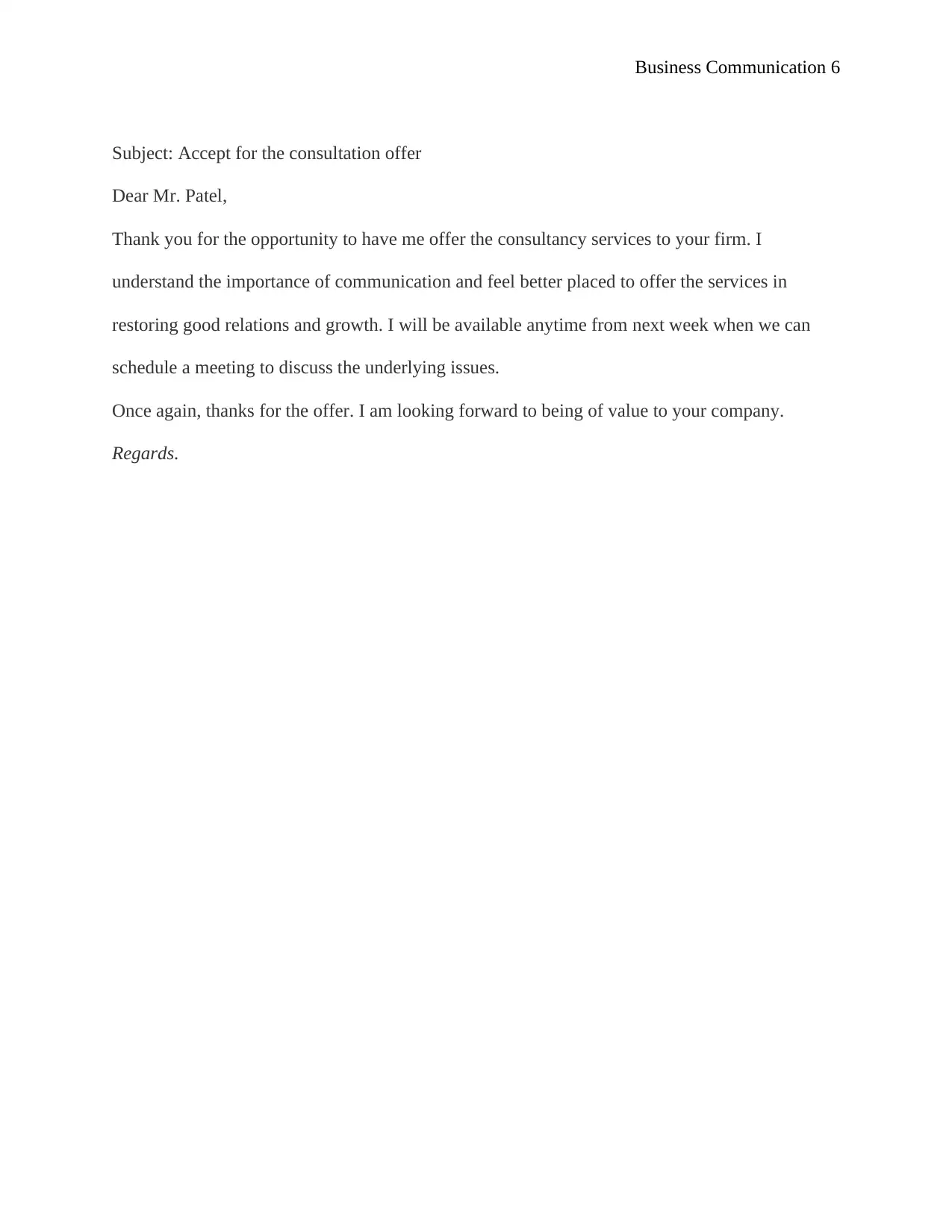
Business Communication 6
Subject: Accept for the consultation offer
Dear Mr. Patel,
Thank you for the opportunity to have me offer the consultancy services to your firm. I
understand the importance of communication and feel better placed to offer the services in
restoring good relations and growth. I will be available anytime from next week when we can
schedule a meeting to discuss the underlying issues.
Once again, thanks for the offer. I am looking forward to being of value to your company.
Regards.
Subject: Accept for the consultation offer
Dear Mr. Patel,
Thank you for the opportunity to have me offer the consultancy services to your firm. I
understand the importance of communication and feel better placed to offer the services in
restoring good relations and growth. I will be available anytime from next week when we can
schedule a meeting to discuss the underlying issues.
Once again, thanks for the offer. I am looking forward to being of value to your company.
Regards.
⊘ This is a preview!⊘
Do you want full access?
Subscribe today to unlock all pages.

Trusted by 1+ million students worldwide
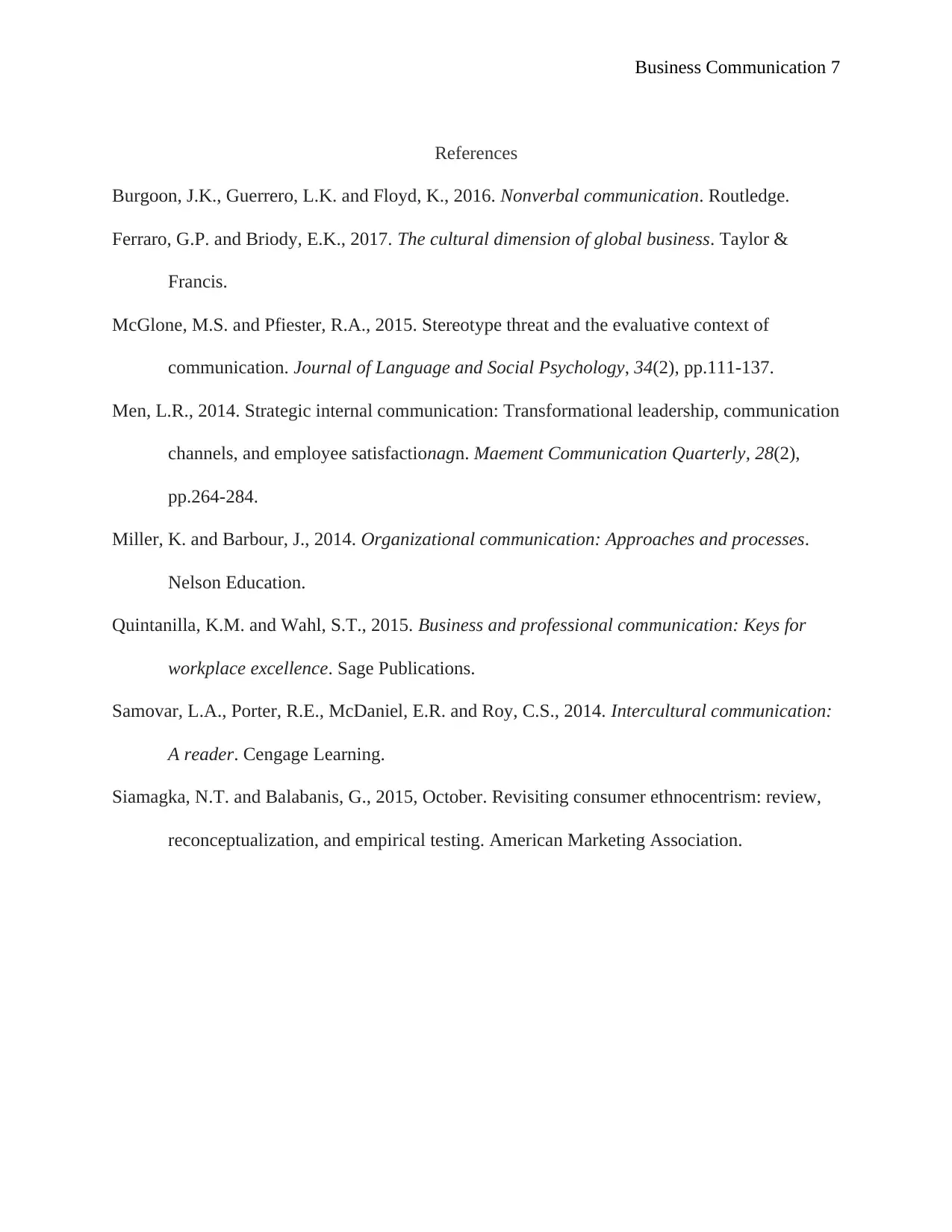
Business Communication 7
References
Burgoon, J.K., Guerrero, L.K. and Floyd, K., 2016. Nonverbal communication. Routledge.
Ferraro, G.P. and Briody, E.K., 2017. The cultural dimension of global business. Taylor &
Francis.
McGlone, M.S. and Pfiester, R.A., 2015. Stereotype threat and the evaluative context of
communication. Journal of Language and Social Psychology, 34(2), pp.111-137.
Men, L.R., 2014. Strategic internal communication: Transformational leadership, communication
channels, and employee satisfactionagn. Maement Communication Quarterly, 28(2),
pp.264-284.
Miller, K. and Barbour, J., 2014. Organizational communication: Approaches and processes.
Nelson Education.
Quintanilla, K.M. and Wahl, S.T., 2015. Business and professional communication: Keys for
workplace excellence. Sage Publications.
Samovar, L.A., Porter, R.E., McDaniel, E.R. and Roy, C.S., 2014. Intercultural communication:
A reader. Cengage Learning.
Siamagka, N.T. and Balabanis, G., 2015, October. Revisiting consumer ethnocentrism: review,
reconceptualization, and empirical testing. American Marketing Association.
References
Burgoon, J.K., Guerrero, L.K. and Floyd, K., 2016. Nonverbal communication. Routledge.
Ferraro, G.P. and Briody, E.K., 2017. The cultural dimension of global business. Taylor &
Francis.
McGlone, M.S. and Pfiester, R.A., 2015. Stereotype threat and the evaluative context of
communication. Journal of Language and Social Psychology, 34(2), pp.111-137.
Men, L.R., 2014. Strategic internal communication: Transformational leadership, communication
channels, and employee satisfactionagn. Maement Communication Quarterly, 28(2),
pp.264-284.
Miller, K. and Barbour, J., 2014. Organizational communication: Approaches and processes.
Nelson Education.
Quintanilla, K.M. and Wahl, S.T., 2015. Business and professional communication: Keys for
workplace excellence. Sage Publications.
Samovar, L.A., Porter, R.E., McDaniel, E.R. and Roy, C.S., 2014. Intercultural communication:
A reader. Cengage Learning.
Siamagka, N.T. and Balabanis, G., 2015, October. Revisiting consumer ethnocentrism: review,
reconceptualization, and empirical testing. American Marketing Association.
1 out of 7
Related Documents
Your All-in-One AI-Powered Toolkit for Academic Success.
+13062052269
info@desklib.com
Available 24*7 on WhatsApp / Email
![[object Object]](/_next/static/media/star-bottom.7253800d.svg)
Unlock your academic potential
Copyright © 2020–2025 A2Z Services. All Rights Reserved. Developed and managed by ZUCOL.





